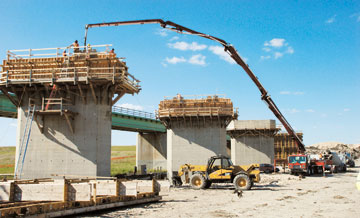
21 August 2009
Winnipeg's Red River Floodway Bridge Contracts Flow to PCL, M.D. Steele

The CPR Emerson Railway bridge over the Red River Floodway in
Manitoba is being raised to the 1-in-700 year flood level.
 Winnipeg Manitoba - The final two of eight bridge
contracts in the $665 million Red River Floodway have been awarded as work continues on the project after being delayed due to
flooding.
Winnipeg Manitoba - The final two of eight bridge
contracts in the $665 million Red River Floodway have been awarded as work continues on the project after being delayed due to
flooding.
PCL and Winnipeg-based M.D. Steele Construction Ltd. were awarded the contracts worth a total of $25 million. PCL will
demolish the existing PTH 44 Highway Bridge over the floodway, building a new one in its place with the associated road works and
upgrades. Likewise, M.D. Steele will do the same for the PTH 15 Highway Bridge. Work on both bridges began recently and is expected to
be completed in the fall of 2010.
Meanwhile, following a spring flood that delayed construction until June, work is now in full swing on two rail bridges that are also
part of the floodway expansion project.
The bridges are the two single largest remaining components of a large and complex land excavation and civil engineering project. The
floodway expansion project, which was started in 2005 and is slated for completion in 2010, will increase floodway channel capacity by
two-and-one-half times and raise the level of protection in a region which is prone to flooding.
The bridges, located in the CPR's Keewatin and Emerson subdivisions, are in the northeast and southeast corners of Winnipeg,
respectively. Work began on reconstruction of the Keewatin bridge in November 2007 and on replacement of the Emerson bridge in July
2008. The general contractor in both cases is M.D. Steele.
Doug McNeil, Vice President Engineering and Construction, Manitoba Floodway Authority, says the substructure of the
11-span, 305-metre Keewatin bridge is completed, steel girders have been erected and wooden deck forms
constructed.
Work on the 11-span, 285-metre long Emerson bridge is proceeding in two stages. Because the soil is plastic
"Manitoba gumbo" clay, construction of sand and gravel embankments took place in 2007, to give the clay underneath time to
settle. Work on the bridge itself began in 2008.
The Emerson bridge is a replacement for an existing rail crossing that is slightly upstream.
"The old bridge is eight feet below the level of the replacement," McNeil said. "It needs to be replaced because it is
a hydraulic restriction that will impede the flow of the floodway when it is completed.".
The switch-over to the new Emerson bridge, which will require the CPR rail line in the Emerson Subdivision to be shut
down for 36 hours, is expected to take place in early September.
"Everything will be ready in case there's another flood next spring," McNeil said.
Because the bridge projects, and the floodway expansion as a whole, are being undertaken on the periphery of a large city with a great
deal of in-place infrastructure, logistics and scheduling were often a challenge.
"There were significant operational issues because of the busy CPR rail lines," McNeil said. "The Keewatin bridge is on
the railway's main east-west line."
Work had to be spread out so that local suppliers weren't overwhelmed or critical materials weren't put to use immediately.
"For example, you can't fabricate highway bridge concrete girders and let them sit for more than nine months, or they'll continue
to camber," McNeil said.
Manitoba's long, severe winters presented another challenge. Contractors needed to ensure that rail switch-overs took
place in the summer, because of possible problems from ballast settling unevenly if laid during cold weather.
Overall, the expansion project comprises widening the 48-kilometre long floodway channel, replacement or upgrade of eight
road and rail bridge crossings, relocation of the City of Winnipeg Aqueduct, extension of the West Dike, and upgrading of the inlet
structure and construction of a new outlet structure.
The floodway is a critical part of southern Manitoba's infrastructure. In the early 1960s, following a particularly damaging 1950
flood, the Manitoba government built a floodway that diverted the Red around Winnipeg on the city's east side.
After the 1997 "Flood of the Century," the International Joint Commission reviewed Manitoba's flood protection
infrastructure. It found there was a high risk it would fail under 1997-like flow conditions. After considering its
options, the government decided to expand the floodway.
Peter Caulfield
|
|